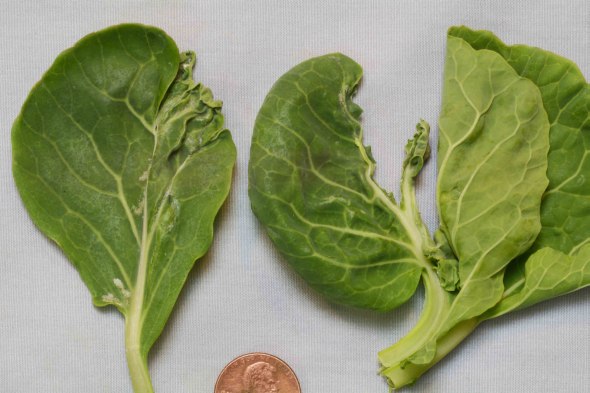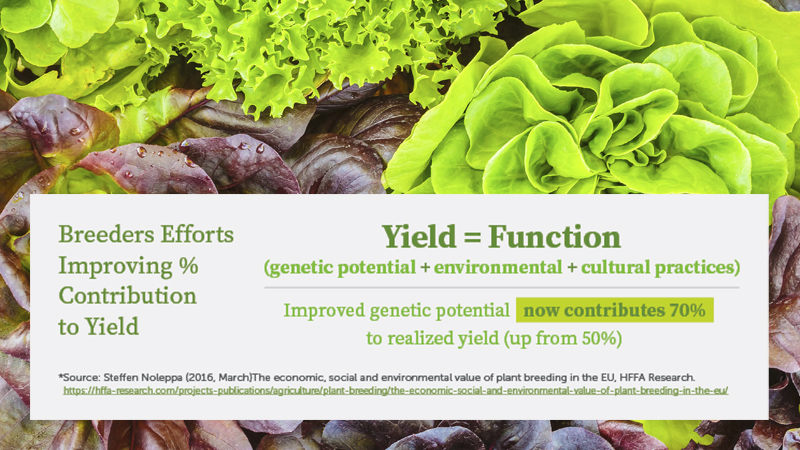Weather Changes Alter Pest Populations, Plant Pathogens

Drought-related weather in California indirectly brought about unusual disease developments,
such as deformities of cole crops caused by cucumber mosaic virus.
Photo credit: Steve Koike
California is notorious for its long and threatening wildfire season. However, the current drought and accompanying weather conditions have made this normally dangerous annual problem a vicious, destructive emergency. Our state’s CAL FIRE agency reports that from January through mid-September 2015, there were more than 5,200 wildfires that burned more than 210,000 acres (in contrast, a five-year average for the same time period had approximately 3,600 wildfires that burned 84,500 acres).
To the 2015 tally, we have to add two more wildfires. Weather drives these fires through direct and indirect effects. This four-year drought and accompanying high temperatures resulted in early drying of grassland, pastures, chaparral, and forests. California doesn’t get summer rains, even if there isn’t a drought. Add hot summer temperatures, really low relative humidity, and warm winds and you get the explosive fire situation we are now living through.
The Insect Impact
The effects of drought and summer weather conditions on insects also had indirect impacts that contributed to the intensity of wildfires this season. Bark beetles are an interesting example of this weather/biology interaction. The long-term drought has caused thousands of forest trees to become stressed. These beetles can sense trees that are weakened and will colonize them. Bark beetle-infested trees either are stressed further or will die outright. Either way, such trees contribute huge amounts of wood to the already sizable supply of flammable fuel that is feeding the wildfires in 2015.
Farmers and other field professionals know this weather/biology dynamic applies to commercial farming, as well. The weather trends in the West are certainly driving the biology we see in the commercial agricultural fields. Even plant diseases have been influenced by these weather developments.
An Eruption Of Viruses
In 2015, the drought resulted in the significant increase of virus diseases in vegetable crops grown in coastal California. The coastal vegetable producing valleys are surrounded by foothills, pastures, riverbeds, and other lands that are covered with weeds, endemic plants, and other diverse species. In this huge mass of vegetation, some of the plants are infected with viruses. Also present in this habitat are large numbers of insects; many of these insects, such as aphids and thrips, are efficient carriers of the viruses.
When these plants dried up prematurely in January and February, due to the drought, hordes of insects fled the dead vegetation and migrated down onto the crops in the valley, bringing the virus pathogens with them. The warmer-than-usual spring and summer weather in coastal California enabled insect-vector populations to remain high and problematic throughout the season.
Early And Rare Outbreaks
As a result, unprecedented virus outbreaks occurred very early in the Salinas Valley and growers saw viruses that are rarely seen on these commodities. Lettuce was the most severely affected. Alfalfa mosaic virus, cucumber mosaic virus, and turnip mosaic virus are rarely seen on California lettuce but caused extensive yellowing, leaf deformities, stunted growth, and therefore significant damage in 2015.
Two other lettuce pathogens, impatiens necrotic spot virus and tomato spotted wilt virus, are not rare on lettuce but got an early start in the spring and continued to be problems throughout the entire season.
Other leafy vegetables were damaged by this unexpected virus development. Spinach, which is a commodity with extremely high quality standards, became twisted in shape and yellow in color when infected with cucumber mosaic virus or impatiens necrotic spot virus. Beet and Swiss chard plantings also turned yellow when attacked by cucumber mosaic virus or beet curly top virus.
Additional Damage
The inundation of viruses onto cultivated fields also caused diseases to some crops that normally don’t suffer from viruses in California. The Salinas Valley is home to broad expanses of cole crop plantings. Typically, Brussels sprouts, broccoli, cabbage, and cauliflower are free from virus problems. However, the weather dynamics of 2015 changed that and Brussels sprouts and cauliflower plants showed strange leaf distortions and mangled growing points. Cucumber mosaic virus was detected and was associated with these cole crop problems.
The California drought and unusually warm temperatures in 2015 are reminders that climate is a key driver for biological systems everywhere, including those in agriculture. As weather changes, so do populations of plant pathogens, insects, and other pests. Extremes in weather can exert both direct and indirect stresses on crops. While the weather is, of course, beyond anyone’s control, an awareness of the possible impacts of weather on agricultural systems may help growers anticipate and deal with some of the many challenges of growing crops.










